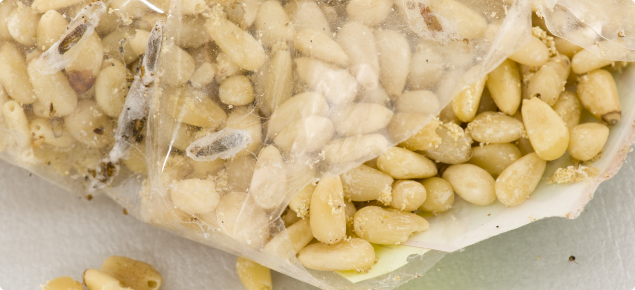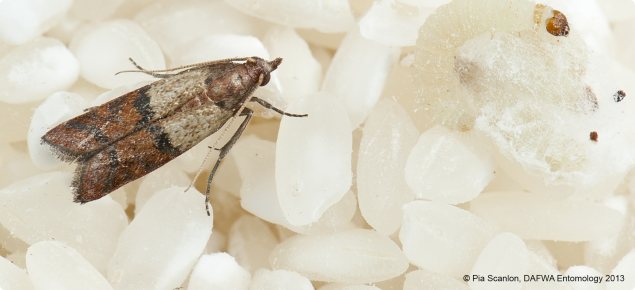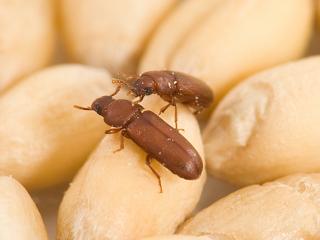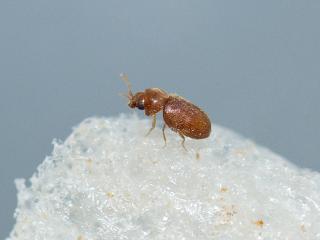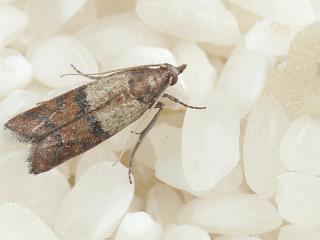Stored food insects
Grain weevils
True weevils can be distinguished from other grain insects by their long snouts which contain their mouth parts.
The female weevil chews a small hole into the grain or other solid food material, deposits an egg, then seals the hole with a gelatinous substance. The larvae hatch and feed within the foodstuff until they pupate, eventually emerging as adults. This segment of the life cycle takes four to six weeks and the adults can live up to eight months, laying 300–400 eggs in this time.
Western Australia has two common grain weevils, the rice weevil (Sitophilus oryzae) and the granary weevil (Sitophilus granarius). Rice weevil adults can fly. They are 2.5–3.5mm long and reddish-brown with four paler brown spots on the wing covers. Granary weevils are flightless, 2.5–4.0mm long and shiny dark brown to black.
Flour beetles
Flour beetles lack the typical weevil snout, are 3–4mm long and reddish-brown. Unlike the weevils they are secondary pests, which means they are unable to attack sound kernels.
They generally infest products such as flour, oatmeal and bran, but occasionally can be found in dried fruits, spices and chocolate. Each female lays up to 400 eggs loosely among food materials. Larvae hatch and feed on fragments of food along with the adults. The life cycle takes four to eight weeks and adults may live as long as 12 months.
The two most common species in Western Australia are the rust red flour beetle (Tribolium castaneum) and the confused flour beetle (Tribolium confusum). Apart from some minor differences, these two species look very similar. However, unlike the rust red flour beetle, the confused flour beetle does not fly.
Cigarette beetle
The cigarette beetle (Lasioderma serricorne), as its name suggests, is primarily a pest of stored tobacco. However, it occasionally breeds in milled cereal, stored grain and spices, even the hot ones like curry powder and cayenne pepper.
The beetles are oval, reddish-yellow and 2–3mm long and live for two to four weeks. In a side view they look humped, with a hood-like thorax with the head set beneath it. Each female may lay up to 100 eggs. The entire life cycle takes one to four months.
The emerging adults often chew out through plastic, paper and cardboard packaging, leaving small circular holes.
Sawtoothed grain beetles
The sawtoothed grain beetle (Oryzaephilus surinamensis), is named because of the saw tooth-like projections around its thorax and is a cosmopolitan pest of stored grain and grain products.
Adult beetles may live for more than three years, in which time each female lays up to 300 eggs. Development from egg to adult takes three to four weeks. Large numbers can develop unnoticed in undisturbed household foodstuffs.
Warehouse beetle
The warehouse beetle (Trogoderma variabile), is a major pest of stored grain. Large quantities of cast larval skins can accumulate in and around infested material and cause allergenic reactions to workers. It looks similar to the khapra beetle, the world’s worst pest of stored grain, which is not in Australia.
The adult beetle is 2–3mm long, oval, brown and the wing cases have an irregular pale marking. They are strong fliers. The larvae are very hairy and infestations are often first noticed by clusters of cast larval skins.
Stored product moths
There are three major storage moths in Western Australia: the Indian meal moth (Plodia interpunctella), the Mediterranean flour moth (Ephestia kuehniella) and the tropical warehouse moth (Ephestia cautella). The Indian meal moth is one of the most common moth pests found in home groceries.
This moth, which has a wingspan of about 15mm, is the parent of the pinkish-white grubs often found in food such as raisins, dates and figs. The grubs also have been known to feed on biscuits, powdered milk and chocolate. They contaminate foodstuffs with webbing. The larvae grow to 17mm long, with a dark head capsule and three pairs of legs. The moth lays eggs on or near foodstuffs. The life cycle usually takes one to three months.
Prevention
Absolute cleanliness in and around food storage areas is essential in preventing infestation. Thoroughly clean up any spilt foodstuffs, preferably using a vacuum cleaner. Pay particular attention to cracks and crevices.
Purchasing small quantities of foodstuffs at a time, keeping them cool, and storing them in containers with close fitting lids can help prevent insect attack and spread.
Often, infestation can be traced to an old packet of dried fruit, flour or spices which has been pushed to the back of a cupboard and forgotten. Destroy all such centres of breeding by placing small quantities of infested material in plastic bags in the freezer compartment of a refrigerator for 48 hours to kill the insects.
Thoroughly clean insect-infested cupboards or pantries and spray them with surface sprays which contain insecticides. Avoid contaminating food, food preparation surfaces, utensils or humans with the spray. After using any spray, air the cupboards for 12 hours before replacing foodstuffs. Space sprays containing pyrethrins are also effective in controlling wandering adult insects in surrounding areas. This prevents them from recontaminating foodstuffs during the airing phase.
An alternative to insecticides is a pantry moth trap. These contain a pheromone lure that attracts the moths and a sticky trap that captures the pests. Moths find traps placed within 3m of the infested food source.
Treatment
You can treat small quantities of food if the insect damage does not require it to be destroyed. Put it in the oven for at least an hour bringing the temperature up to 55–60ºC but no hotter. Gradual heating will raise all material to the desired temperature, but short intense heating may spoil the commodity being treated. During hot summer weather, spreading the material thinly on an iron tray and placing it in the sun for several hours will also kill the pests.
If larger quantities of food need to be treated, see a registered pest controller with a view to fumigation.
Biosecurity message
The khapra beetle (Trogoderma granarium) is an exotic pest not present in Australia and is considered the world’s most destructive pest of stored grains and grain products.
If you discover this pest or its larva in any of your stored grain or grain products contact the Pest and Disease Information Service on free call 1800 084 881 or email info@agric.wa.gov.au
Khapra beetle
The khapra beetle larvae are up to 7mm long. They are yellowish at first, then the colour darkens with each moult to red-brown. Adults are oval, dark brown beetles about 2.5mm long with yellow-brown to red-brown markings on the wing covers. The larvae and their cast skins are the most conspicuous feature of a khapra beetle infestation.
Feeding is usually concentrated over the surface of infested materials and down the sides of bins, but may penetrate six metres or more into bulk storage.
The beetle is typically a pest of hot dry climates and it is likely that khapra would also get a foothold in Western Australia if quarantine violations occur.
To learn more about this pest, please refere to the khapra beetle webpage.

